How Many Protons Does Calcium Have?
Every single discovered atom have protons, electrons, and neutrons. The number of each depends on its assigned atomic number. Protons have a positive charge, electrons have a negative charge and, as the name implies, neutrons have no charge.
Element Properties in the Periodic Table
Element Properties in the Periodic Table
When looking at an element in the periodic table, there are two numbers: the atomic number, which is found at the top, and the atomic weight, which is found at the bottom of the box.
How Many Protons in Calcium?
How Many Protons in Calcium?
The number of protons found in the nucleus of calcium is the same as its atomic number: 20.
Electrons
Electrons
The number of electrons and the number of protons are always the same, unless the element is given another charge.
Neutrons
Neutrons
The atomic mass, the number at the bottom, is the sum of the number of protons and the number of neutrons. Just subtract the number of protons, 20 in this case, from the rounded number of the mass.
Isotopes
Isotopes
Changing the number of neutrons will change the element to another version of itself, called an isotope.
Cite This Article
MLA
Contributor, . "How Many Protons Does Calcium Have?" sciencing.com, https://www.sciencing.com/many-protons-does-calcium-have-4964140/. 24 April 2017.
APA
Contributor, . (2017, April 24). How Many Protons Does Calcium Have?. sciencing.com. Retrieved from https://www.sciencing.com/many-protons-does-calcium-have-4964140/
Chicago
Contributor, . How Many Protons Does Calcium Have? last modified March 24, 2022. https://www.sciencing.com/many-protons-does-calcium-have-4964140/
